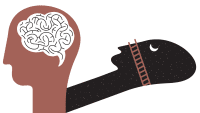HEALTH POLICY is essential to promote wellness and make sure that large scale health goals are met, and standards of care are upheld. As of March 2022, Kansas had the 12th highest number of suicides out of all 50 states in the United States (US) (Centers for Disease Control [CDC], 2022). The policy issue is suicide. The goal is to save lives and decrease demand on the healthcare system by enabling staff to rapidly identify trauma history and tailoring patient treatment plans to each individual circumstance.
Proposed Change
The policy change being proposed would require identification of childhood trauma on admission of suicidal patients to the hospital and then individualization of their treatment plans/ plan of care, based on these findings. This will leave it open to how childhood trauma is identified. It will also allow organizations to utilize different tools that are most appropriate to their clientele.
Supporting Evidence
Supporting evidence was chosen with the intent to show that childhood trauma does in fact lead to suicidal ideation as an adult, as well as other issues. This supports the notion of requiring identification of childhood trauma upon the admission of suicidal patients to the hospital. If this is not done then treatment plans may not really get to the root of the patients’ problem, leading to repeat crisis for the patient.
Childhood Trauma and Suicide
Behr Gomes Jardim et al. (2018) performed a cross sectional study to determine the influence of childhood abuse and trauma on depression and suicide risk later in life. They found that childhood neglect, as well as abuse, was a significant precursor to suicide risk. Oquendo et al. (2020) determined that childhood trauma was a predictor for suicidal ideation variability, and that it caused a greater increase of suicidal ideation after being exposed to a stressor.
Gaweda et al. (2019) performed a study to determine the relationship between childhood trauma, psychotic-like experiences (PLE), and depression on suicidal ideation. They found a five-fold increase in suicidal ideation for those that suffered from childhood trauma and PLEs, and a six-fold increase in those with depression. Angelakis et al. (2019) found a two to three-fold increase in suicide attempts in adults when there was a history of childhood trauma. Grattan et al. (2019) found that trauma history is associated with suicidal ideation, non-suicidal self-injurious behavior, and aggression.
Childhood Trauma and Comorbidities
Sonu et al. (2019) performed a study to determine whether childhood trauma is associated with adult disease and disability. They found that those with increased childhood trauma were two to four times more likely to develop chronic health conditions and poor health status than those with no trauma. Kazan Kızılkurt et al. (2021) found that childhood trauma was positively correlated with fibromyalgia symptoms. Brindle et al. (2018) found that childhood trauma was greatly associated with poor sleep as an adult. Lei et al. (2018) found that childhood trauma was positively correlated with symptoms of cardiovascular disease in young adulthood.
Wen et al. (2022) performed a study to determine how first-degree relatives of someone who experienced childhood trauma, that did not experience it themselves, were affected. They found that the unaffected relatives were more likely to have some personality traits. Those traits include, but are not limited to, neuroticism and psychoticism.
Conclusion
Healthcare reform has come a long way over the last century. However, there is still a lot of progress that needs to be made. With more regulation and policy changes around mental health, specifically suicidal ideation, we can not only save lives but also decrease the demand on the US healthcare system.
References
Angelakis, I., Gillespie, E. L., & Panagioti, M. (2019). Childhood maltreatment and adult suicidality: A comprehensive systematic review with meta-analysis. Psychological Medicine, 49(07), 1057–1078. https://doi.org/10.1017/s0033291718003823
Brindle, R. C., Cribbet, M. R., Samuelsson, L. B., Gao, C., Frank, E., Krafty, R. T., Thayer, J. F., Buysse, D. J., & Hall, M. H. (2018). The relationship between childhood trauma and poor sleep health in adulthood. Psychosomatic Medicine, 80(2), 200–207. https://doi.org/10.1097/psy.0000000000000542
Behr Gomes Jardim, G., Novelo, M., Spanemberg, L., von Gunten, A., Engroff, P., Nogueira, E. L., & Cataldo Neto, A. (2018). Influence of childhood abuse and neglect subtypes on late-life suicide risk beyond depression. Child Abuse & Neglect, 80, 249–256. https://doi.org/10.1016/j.chiabu.2018.03.029
Centers for Disease Control [CDC], (2022). Stats of the state – suicide mortality. August 31, 2022, from https://www.cdc.gov/nchs/pressroom/sosmap/suicide-mortality/suicide.htm
Gaw˛eda, Ł., Pionke, R., Kr˛e˙zołek, M., Frydecka, D., Nelson, B., & Cechnicki, A. (2019). The interplay between childhood trauma, cognitive biases, psychotic-like experiences and depression and their additive impact on predicting lifetime suicidal behavior in young adults. Psychological Medicine, 50(1), 116–124. https://doi.org/10.1017/s0033291718004026
Grattan, R. E., Lara, N., Botello, R. M., Tryon, V. L., Maguire, A. M., Carter, C. S., & Niendam, T. A. (2019). A history of trauma is associated with aggression, depression, non-suicidal self-injury behavior, and suicide ideation in first-episode psychosis. Journal of Clinical Medicine, 8(7), 1082. https://doi.org/10.3390/jcm8071082
Kazan Kızılkurt, Ö., Kazım Demirkan, A., Ergün Gıynas¸, F., & Güleç, H. (2021). Effect of childhood trauma on disease severity in patients with fibromyalgia: The mediating role of psychological resilience. Archives of Rheumatology, 36(4), 538–547. https://doi.org/10.46497/archrheumatol.2021.8477
Lei, M.-K., Beach, S. R., & Simons, R. L. (2018). Childhood trauma, pubertal timing, and cardiovascular risk in adulthood. Health Psychology, 37(7), 613–617. https://doi.org/10.1037/hea0000609
Oquendo, M. A., Galfalvy, H. C., Choo, T.-H., Kandlur, R., Burke, A. K., Sublette, M. E., Miller, J. M., Mann, J. J., & Stanley, B. H. (2020). Highly variable suicidal ideation: A phenotypic marker for stress induced suicide risk. Molecular Psychiatry, 26(9), 5079–5086. https://doi.org/10.1038/s41380-020-0819-0
Sonu, S., Post, S., & Feinglass, J. (2019). Adverse childhood experiences and the onset of chronic disease in young adulthood. Preventive Medicine, 123, 163–170. https://doi.org/10.1016/j.ypmed.2019.03.032
Wen, Y.-jie, Bo, Q.-jing, Hou, W.-peng, Mao, Z., Li, F., He, F., Dong, F., Ma, X., Tang, Y.-lang, Li, X.-bin, & Wang, C.-yue. (2022). The effects of childhood trauma on personality in unaffected first-degree relatives of patients with major depressive disorder. BMC Psychiatry, 22(1). https://doi.org/10.1186/s12888-022-03909-z





























